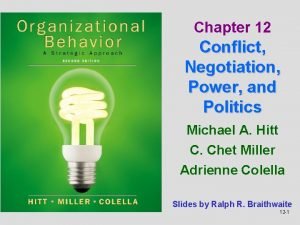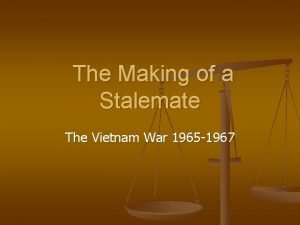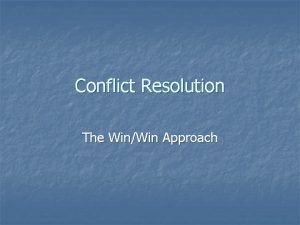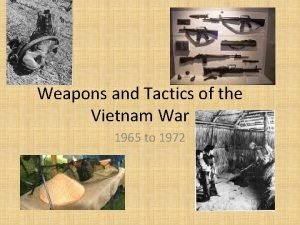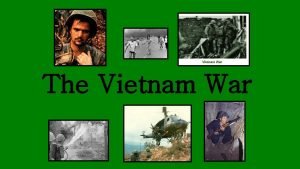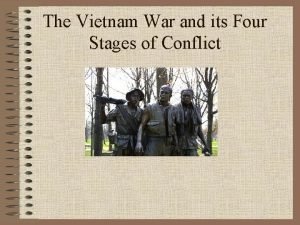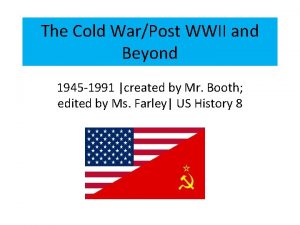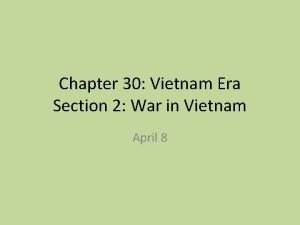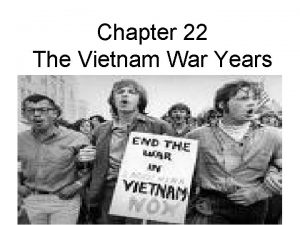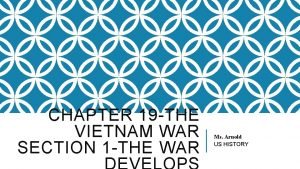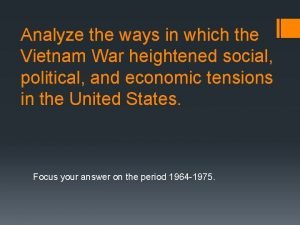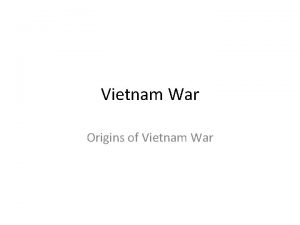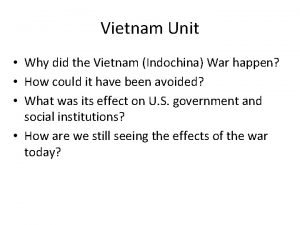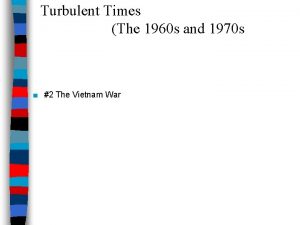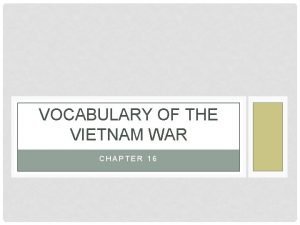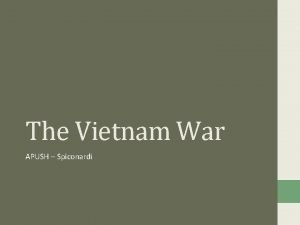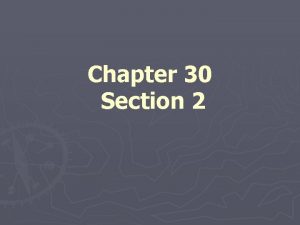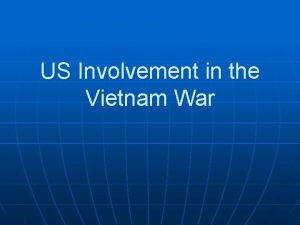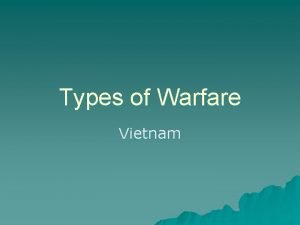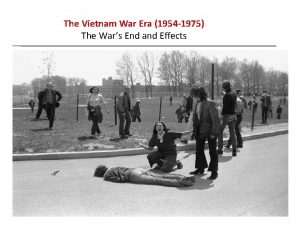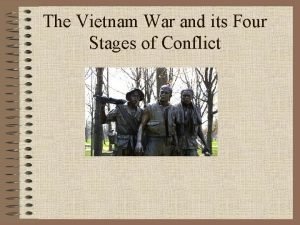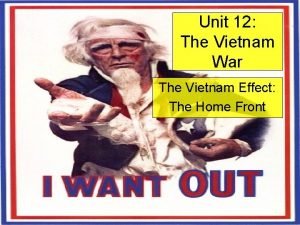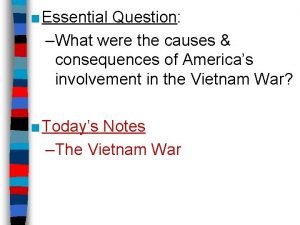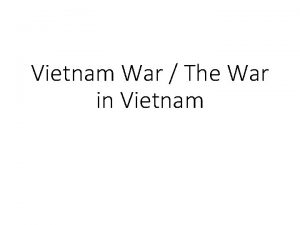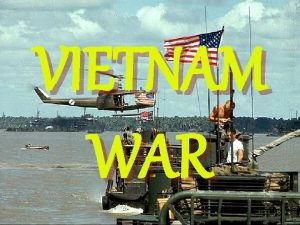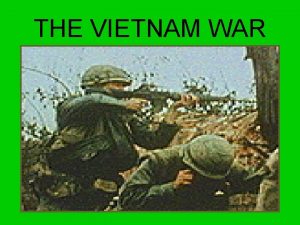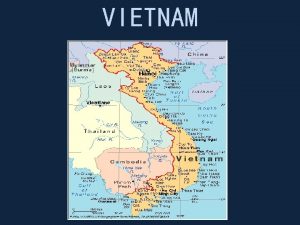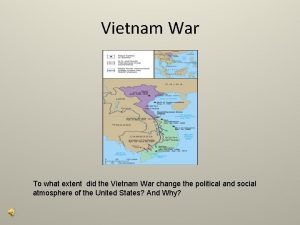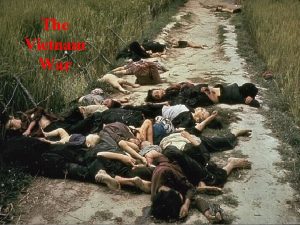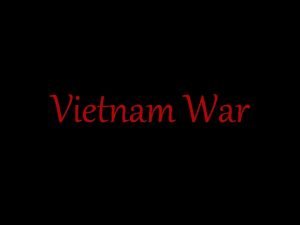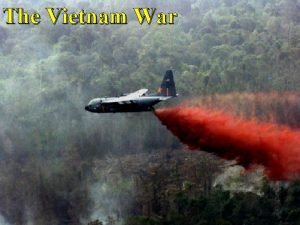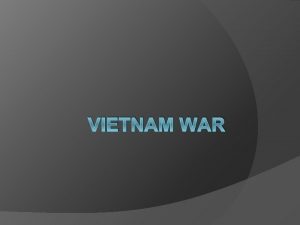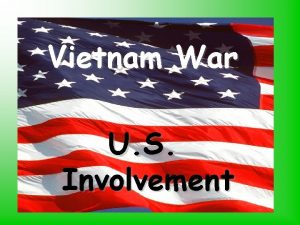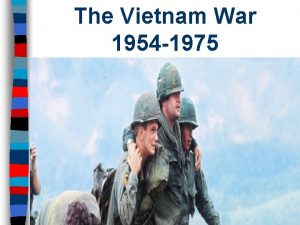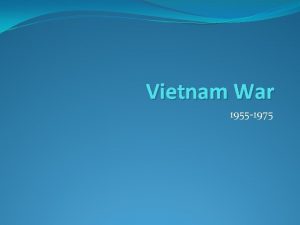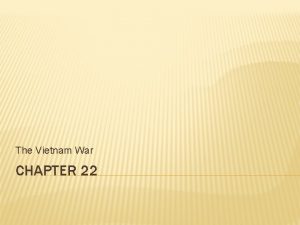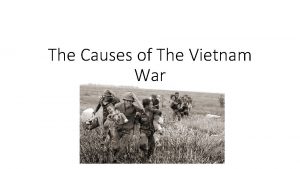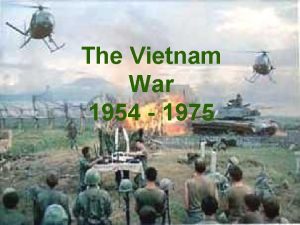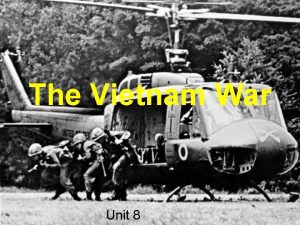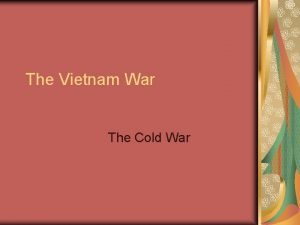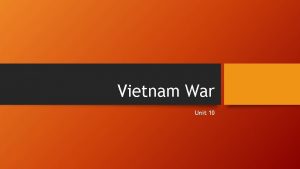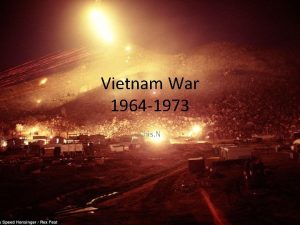Vietnam War How did the US lose when

































- Slides: 33

Vietnam War How did the US lose when the odds were in their favour? ? ?

Focus Questions • Why was the Vietnam War so controversial? • Why did America lose the Vietnam War? • What were the policies of Lyndon B. Johnson and Richard Nixon, the stated reasons for those policies, and the results? • How did nationalism play a role in the war from the Vietnamese perspective?

Difference between Korean War and Vietnam: • Korean War was fought by foreign forces VS • Vietnam War fought by Nationalists against foreign forces

• Vietnam is under the control of China until French Colonialism in 1885 after a war with China • Japan takes Indochina (Vietnam) during WWII • France attempts to reoccupy Vietnam after WWII • America aids France but France is defeated and America continues Background

Vietnam • Ngo Dinh Diem, the ruler of South Vietnam, refused to hold elections • Ho Chi Minh (communist supported by China) set up the National Liberation Front (NLF)/ Vietcong (to the US) in South Vietnam In 1960 – started a guerrilla war to take over South Vietnam from Diem – Guerrilla warfare utilizes knowledge the surroundings to defeat the enemy physically and psychologically • In 1963, the US supported a military coup, which murdered Diem and put a military government in South Vietnam

Gulf of Tonkin Incident • August 2, 1964, US ship is torpedoed by a N. Vietnamese ship • Two days later another ship is attacked • August 7, the Gulf of Tonkin Resolution is passed by President Lyndon Johnson – Not a declaration of war but “necessary steps” to protect the US Photograph taken from USS Maddox (DD-731) during her engagement with three North Vietnamese motor torpedo boats in the Gulf of Tonkin, 2 August 1964. The view shows one of the boats racing by, with what appears to be smoke from Maddox' shells in its wake.

President Johnson's Message to Congress August 5, 1964 “As President of the United States I have concluded that I should now ask the Congress, on its part, to join in affirming the national determination that all such attacks will be met, and that the United States will continue in its basic policy of assisting the free nations of the area to defend their freedom. As I have repeatedly made clear, the United States intends no rashness, and seeks no wider war. We must make it clear to all that the United States is united in its determination to bring about the end of Communist subversion and aggression in the area. We seek the full and effective restoration of the international agreements signed in Geneva in 1954, with respect to South Vietnam, and again in Geneva in 1962, with respect to Laos. . . “ http: //avalon. law. yale. edu/20 th_century/tonkin-g. asp

Reasons for the US declaring war 1. Policy of Containment/ Domino Theory 2. Weakness of the AVRN (South Vietnamese Army) 3. Attacks from the Vietcong on the Americans

Spark of War • February 1965, Vietcong attacks American air bases in Vietnam and killed American soldiers – US declares war against N. Vietnam Vietcong attack on U. S. military barracks at Pleiku

The War in Vietnam Operation Rolling Thunder: • February 1965 • Bombing against N. Vietnam

The War in Vietnam 2) Air attack on Ia Drang: • November 1965 • US troops lure the NVA (North Vietnamese Army) into Ia Drang and then attacked by air

The War in Vietnam 3) Phoenix Program: • 1967 -70 • US begins to arrest, interrogate and kill suspected Vietcong activists in Vietnam • Most documents about the program were destroyed in the 70 s • Goes against the Geneva Convention “Indeed, a US officer would lament on this "mania of the body count" propelling Phoenix. Operatives found it a "matter of expediency just to eliminate a person in the field rather than deal with the paperwork. " An "awful lot of vendettas (were) carried out with Phoenix license" where covert operatives—which included ex-convicts, corrupt police and military officials, and other mercenaries attracted to the CIA money—"assassinated a lot of the wrong damn people. " http: //www. bulatlat. com/news/6 -34 -phoenix. htm

The War in Vietnam 4) Tet Offensive: • January 1968 • Vietcong and North Vietnam Army directly attack South Vietnam – Lost 58, 000 men • Took 50 small towns + most major cities • NVA and VC retreat but America has seen the resolve of the Northern forces and realizes they’ll need more soldiers to defeat them • Public support for the war is lost

Guerrilla Warfare • NVA and Vietcong would hide in villages to attack Americans • Impossible for Americans to tell who were civilians and who weren’t • Supply routes from China were through the jungles so it was difficult for Americans to cut it off (also could start a war with China) • NVA would stay close to American troops to prevent air attacks • Demoralizes American troops and gains more support from villagers for the NVA Massacre of 300 civilians at My Lai • ambushing US patrols, setting booby traps and landmines, and planting bombs in towns

Vietnamization • Nixon is President in 1969 and wins on a policy of ending the war – Turn over control of the war to the South Vietnamese and get Americans out – Support the South financially

The differences between the Americans and the Vietcong Americans Vietcong

The differences between the Americans and the Vietcong Americans The American hi-tech tactics continually killed the wrong people and demoralised their own troops. Vietcong

The differences between the Americans and the Vietcong Americans Vietcong The American hi-tech tactics continually The Vietcong's guerrilla tactics were killed the wrong people and appropriate to the nature of the conflict. demoralised their own troops.

The differences between the Americans and the Vietcong Americans Vietcong The American hi-tech tactics continually The Vietcong's guerrilla tactics were killed the wrong people and appropriate to the nature of the conflict. demoralised their own troops. The US was trying to supply a war 8, 000 miles from America.

The differences between the Americans and the Vietcong Americans Vietcong The American hi-tech tactics continually The Vietcong's guerrilla tactics were killed the wrong people and appropriate to the nature of the conflict. demoralised their own troops. The US was trying to supply a war 8, 000 miles from America. The Vietcong were supplied with weapons by China and Russia.

The differences between the Americans and the Vietcong Americans Vietcong The American hi-tech tactics continually The Vietcong's guerrilla tactics were killed the wrong people and appropriate to the nature of the conflict. demoralised their own troops. The US was trying to supply a war 8, 000 miles from America. The South Vietnamese regime was weak, brutal and corrupt. The Vietcong were supplied with weapons by China and Russia.

The differences between the Americans and the Vietcong Americans Vietcong The American hi-tech tactics continually The Vietcong's guerrilla tactics were killed the wrong people and appropriate to the nature of the conflict. demoralised their own troops. The US was trying to supply a war 8, 000 miles from America. The Vietcong were supplied with weapons by China and Russia. The South Vietnamese regime was weak, brutal and corrupt. The South Vietnamese peasants supported and sheltered the Vietcong.

The differences between the Americans and the Vietcong Americans Vietcong The American hi-tech tactics continually The Vietcong's guerrilla tactics were killed the wrong people and appropriate to the nature of the conflict. demoralised their own troops. The US was trying to supply a war 8, 000 miles from America. The Vietcong were supplied with weapons by China and Russia. The South Vietnamese regime was weak, brutal and corrupt. The South Vietnamese peasants supported and sheltered the Vietcong. Their short (one-year) tour of service meant that American troops were always inexperienced.

The differences between the Americans and the Vietcong Americans Vietcong The American hi-tech tactics continually The Vietcong's guerrilla tactics were killed the wrong people and appropriate to the nature of the conflict. demoralised their own troops. The US was trying to supply a war 8, 000 miles from America. The Vietcong were supplied with weapons by China and Russia. The South Vietnamese regime was weak, brutal and corrupt. The South Vietnamese peasants supported and sheltered the Vietcong. Their short (one-year) tour of service meant that American troops were always inexperienced. The Vietcong had been continuously at war since they resisted the Japanese during the Second World War.

The differences between the Americans and the Vietcong Americans Vietcong The American hi-tech tactics continually The Vietcong's guerrilla tactics were killed the wrong people and appropriate to the nature of the conflict. demoralised their own troops. The US was trying to supply a war 8, 000 miles from America. The Vietcong were supplied with weapons by China and Russia. The South Vietnamese regime was weak, brutal and corrupt. The South Vietnamese peasants supported and sheltered the Vietcong. Their short (one-year) tour of service meant that American troops were always inexperienced. The Vietcong had been continuously at war since they resisted the Japanese during the Second World War. The morale of Americans soldiers was rock bottom - they took drugs, shot their officers ('fragging') and deserted.

The differences between the Americans and the Vietcong Americans Vietcong The American hi-tech tactics continually The Vietcong's guerrilla tactics were killed the wrong people and appropriate to the nature of the conflict. demoralised their own troops. The US was trying to supply a war 8, 000 miles from America. The Vietcong were supplied with weapons by China and Russia. The South Vietnamese regime was weak, brutal and corrupt. The South Vietnamese peasants supported and sheltered the Vietcong. Their short (one-year) tour of service meant that American troops were always inexperienced. The Vietcong had been continuously at war since they resisted the Japanese during the Second World War. The morale of Americans soldiers was rock bottom - they took drugs, shot their officers ('fragging') and deserted. The Vietcong were fanatically determined to drive out the Americans, whatever the cost.

The differences between the Americans and the Vietcong Americans Vietcong The American hi-tech tactics continually The Vietcong's guerrilla tactics were killed the wrong people and appropriate to the nature of the conflict. demoralised their own troops. The US was trying to supply a war 8, 000 miles from America. The Vietcong were supplied with weapons by China and Russia. The South Vietnamese regime was weak, brutal and corrupt. The South Vietnamese peasants supported and sheltered the Vietcong. Their short (one-year) tour of service meant that American troops were always inexperienced. The Vietcong had been continuously at war since they resisted the Japanese during the Second World War. The morale of Americans soldiers was rock bottom - they took drugs, shot their officers ('fragging') and deserted. The Vietcong were fanatically determined to drive out the Americans, whatever the cost. The war became very unpopular in the US, and lost public support.

The differences between the Americans and the Vietcong Americans Vietcong The American hi-tech tactics continually The Vietcong's guerrilla tactics were killed the wrong people and appropriate to the nature of the conflict. demoralised their own troops. The US was trying to supply a war 8, 000 miles from America. The Vietcong were supplied with weapons by China and Russia. The South Vietnamese regime was weak, brutal and corrupt. The South Vietnamese peasants supported and sheltered the Vietcong. Their short (one-year) tour of service meant that American troops were always inexperienced. The Vietcong had been continuously at war since they resisted the Japanese during the Second World War. The morale of Americans soldiers was rock bottom - they took drugs, shot their officers ('fragging') and deserted. The Vietcong were fanatically determined to drive out the Americans, whatever the cost. The war became very unpopular in the The North Vietnamese were motivated, US, and lost public support. fighting at home to unite their country.

Why didn’t Americans support the war? 1. 2. 3. 4. 5. 58, 000 Americans - average 19 - were killed. It was hard for Americans to believe that they were defending America by fighting in a war 8, 000 miles away. Extensive media coverage brought all the failures and horrors of the war into US homes. Atrocities such as the massacre at My Lai undermined the moral authority of the US to continue the war. The war was opposed particularly by Martin Luther King and by America's black community (because wealthier white men could avoid the draft by going to university or to Canada, and young black men were twice as likely to be killed).

Paris Peace Agreement 1973 • Nixon begins operations to bomb the North (ineffective) • North and South forced to sign the peace agreement with the US • US leave Vietnam in January 1973

Evaluate the following quote: “The Vietcong's tactics helped them to defeat the Americans; the Americans' tactics merely helped them to lose. " The Vietcong's tactics • Fought a guerrilla war, ambushing US patrols, setting booby traps and landmines, and planting bombs in towns. They mingled in with the peasants, wearing ordinary clothes. The Americans couldn't identify who the enemy was. • Supplied with rockets and weapons by China and Russia. They used the Ho Chi Minh Trail - a jungle route through Laos and Cambodia - to supply their armies. The Americans couldn't attack their supply routes without escalating the war. • Tactic was "hanging onto the belts" of the Americans - staying so close to the Americans so they could not use air or artillery backup without killing their own men. The Americans' tactics • Fought a hi-tech war, using B 52 bombers, artillery, helicopters, napalm and defoliants (Agent Orange). This killed many innocent civilians, and failed to stop the Vietcong guerrillas. • Forced the peasants to leave Vietcong -controlled areas and made them live in defended strategic hamlets in loyal areas. This created immense opposition, and allowed Vietcong infiltrators into loyal areas. • Troops were sent on patrols, then supported by air and artillery when attacked. This demoralised the soldiers, who realised they were being used just as bait. • Search and destroy patrols went out looking for "Charlie", as they called the Vietcong. But the patrols were very visible, and easy to ambush. This led to atrocities such as "zippo raids" to burn villages, and the unprovoked massacre of peaceful villagers at My Lai in 1968. • http: //www. bbc. co. uk/schools/gcsebitesize/history/mwh/vietnam/thewarinvietnamrev 2. shtml

Vietnam after the War • 1975 South Vietnamese regime collapses and Vietnam is united under communists • NVA massacred South Vietnamese which led to S Vietnamese fleeing by boat • Infrastructure is ruined by war

 Think win-win example
Think win-win example Win win win lose lose lose
Win win win lose lose lose Win-win win-lose lose-lose
Win-win win-lose lose-lose Description
Description Truman vs eisenhower venn diagram
Truman vs eisenhower venn diagram Did the vietnam war end in a stalemate
Did the vietnam war end in a stalemate Habit 4 think win win examples
Habit 4 think win win examples Win-win conflict resolution
Win-win conflict resolution Us weapons vietnam war
Us weapons vietnam war What was the result of the vietnam war
What was the result of the vietnam war Vietnam war stages
Vietnam war stages Civil war digging deeper webquest answers
Civil war digging deeper webquest answers Causes of vietnam war
Causes of vietnam war The vietnam war years chapter 22
The vietnam war years chapter 22 President nixon endorsed vietnamization because
President nixon endorsed vietnamization because Analyze the ways in which the vietnam war heightened social
Analyze the ways in which the vietnam war heightened social The vietnam war
The vietnam war Vietnam war
Vietnam war Napalm vietnam war
Napalm vietnam war Vietnam war 1960
Vietnam war 1960 Vietnam war vocabulary
Vietnam war vocabulary Vietnam war apush
Vietnam war apush Agent orange and napalm
Agent orange and napalm Vietnam war
Vietnam war Punji trap victim
Punji trap victim Reason for vietnam war
Reason for vietnam war Effects of the vietnam war
Effects of the vietnam war Stages of the vietnam war
Stages of the vietnam war Mỹ lai massacre
Mỹ lai massacre Pro vietnam war slogans
Pro vietnam war slogans What were the causes and effects of the vietnam war
What were the causes and effects of the vietnam war Meherjan passage summary
Meherjan passage summary Why did the ionians lose the ionian revolt?
Why did the ionians lose the ionian revolt? Meherjan lives in a slum
Meherjan lives in a slum

